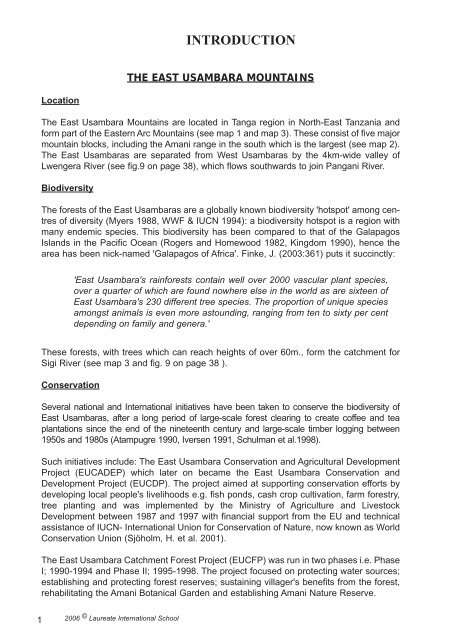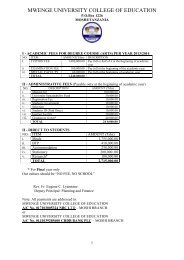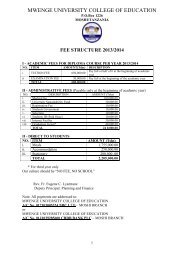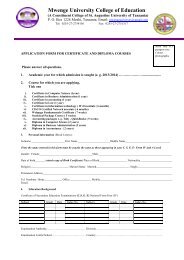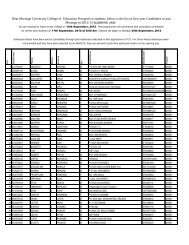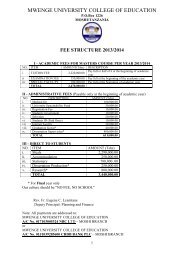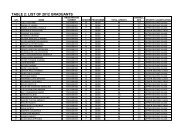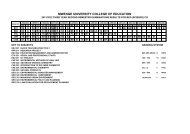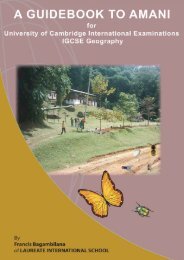Guidebook to Amani - MWUCE
Guidebook to Amani - MWUCE
Guidebook to Amani - MWUCE
You also want an ePaper? Increase the reach of your titles
YUMPU automatically turns print PDFs into web optimized ePapers that Google loves.
INTRODUCTION<br />
THE EAST USAMBARA MOUNTAINS<br />
Location<br />
The East Usambara Mountains are located in Tanga region in North-East Tanzania and<br />
form part of the Eastern Arc Mountains (see map 1 and map 3). These consist of five major<br />
mountain blocks, including the <strong>Amani</strong> range in the south which is the largest (see map 2).<br />
The East Usambaras are separated from West Usambaras by the 4km-wide valley of<br />
Lwengera River (see fig.9 on page 38), which flows southwards <strong>to</strong> join Pangani River.<br />
Biodiversity<br />
The forests of the East Usambaras are a globally known biodiversity 'hotspot' among centres<br />
of diversity (Myers 1988, WWF & IUCN 1994): a biodiversity hotspot is a region with<br />
many endemic species. This biodiversity has been compared <strong>to</strong> that of the Galapagos<br />
Islands in the Pacific Ocean (Rogers and Homewood 1982, Kingdom 1990), hence the<br />
area has been nick-named 'Galapagos of Africa'. Finke, J. (2003:361) puts it succinctly:<br />
'East Usambara's rainforests contain well over 2000 vascular plant species,<br />
over a quarter of which are found nowhere else in the world as are sixteen of<br />
East Usambara's 230 different tree species. The proportion of unique species<br />
amongst animals is even more as<strong>to</strong>unding, ranging from ten <strong>to</strong> sixty per cent<br />
depending on family and genera.'<br />
These forests, with trees which can reach heights of over 60m., form the catchment for<br />
Sigi River (see map 3 and fig. 9 on page 38 ).<br />
Conservation<br />
Several national and International initiatives have been taken <strong>to</strong> conserve the biodiversity of<br />
East Usambaras, after a long period of large-scale forest clearing <strong>to</strong> create coffee and tea<br />
plantations since the end of the nineteenth century and large-scale timber logging between<br />
1950s and 1980s (Atampugre 1990, Iversen 1991, Schulman et al.1998).<br />
Such initiatives include: The East Usambara Conservation and Agricultural Development<br />
Project (EUCADEP) which later on became the East Usambara Conservation and<br />
Development Project (EUCDP). The project aimed at supporting conservation efforts by<br />
developing local people's livelihoods e.g. fish ponds, cash crop cultivation, farm forestry,<br />
tree planting and was implemented by the Ministry of Agriculture and Lives<strong>to</strong>ck<br />
Development between 1987 and 1997 with financial support from the EU and technical<br />
assistance of IUCN- International Union for Conservation of Nature, now known as World<br />
Conservation Union (Sjöholm, H. et al. 2001).<br />
The East Usambara Catchment Forest Project (EUCFP) was run in two phases i.e. Phase<br />
I; 1990-1994 and Phase II; 1995-1998. The project focused on protecting water sources;<br />
establishing and protecting forest reserves; sustaining villager's benefits from the forest,<br />
rehabilitating the <strong>Amani</strong> Botanical Garden and establishing <strong>Amani</strong> Nature Reserve.<br />
1<br />
2006 © Laureate International School


